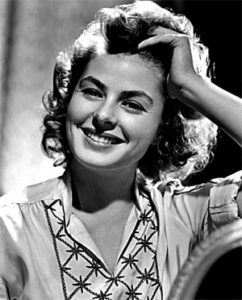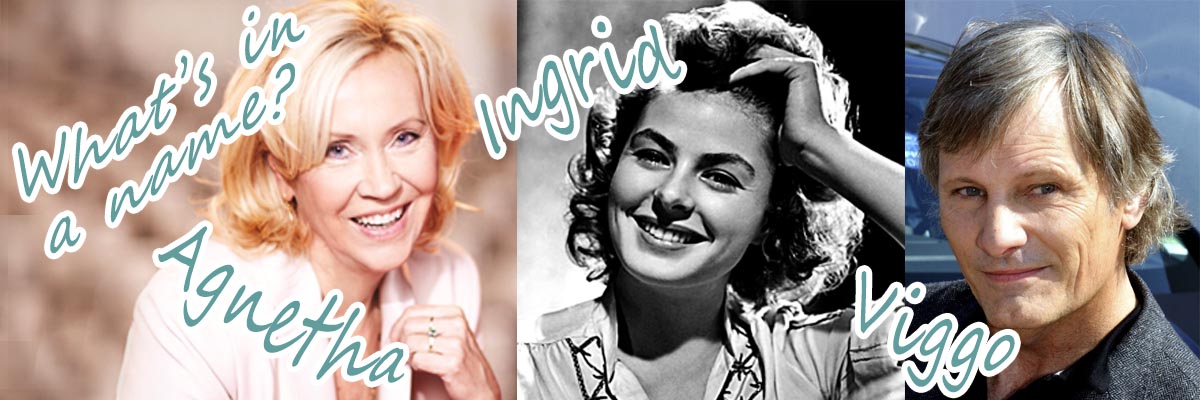Viggo

I was watching an episode of NCIS, the American criminal series that revolves around the US Naval Criminal Investigation Service and they were talking about an enemy agent called Viggo. “Ah,” someone says on hearing the name. “A Russian.” And indeed it turns out this character is a Russian. I suppose for an American the name Viggo may sound Slavic, but if you happen to know Viggo is an ancient Norse name and that it’s still used in parts of Scandinavia, then it’s sudden identification as Russian is mystifying. It also destroys any suspension of disbelief you may have built up in respect of the story you’re following. Certainly I was unable to watch the offending NCIS episode to the end. (Or at least, the misuse of the name is the only thing I can remember about it.)
This would be simply a silly story if it weren’t for the fact that only a week or so after hearing Viggo attributed as a matter of course to a Russian, I was proofreading the beginning of a thriller by another wannabe writer and blow me down if I didn’t find another Russian baddie called Viggo.
What is it about Viggo that is getting English writers to ascribe it to evil Slavs?
Eastern promises
The only answer I can find is that the film actor Viggo Mortensen played the role of a Russian Mafioso in David Cronenberg’s film Eastern Promises.
I’m going to guess that Eastern Promises made such a big impression on certain English-speaking thriller writers that they linked Viggo Mortensen with his character in the film (who was actually called Nikolai) and without any further research decided: Damn it, Viggo must be a Russian mobster!
It doesn’t actually take a great deal of effort to discover that Viggo Mortensen himself is half-Danish, half-American. But these are – perhaps – details too fine to trouble certain creative brains.
Yet they should.
Choosing the right name

Choosing the right name is one of the key elements in building up a fictional character. When you name a character, that name is your label on the character. It’s the quick reference tag you’re going to use to conjure up in your reader’s mind as well as your own a picture of the character whenever you refer to him or her. It’s the handle your reader will grasp to follow the character through your story.
If you make the mistake of giving the character an improbable name (without having a likely reason why they got it), then you are setting your character up to trip your readers into disbelief. Not all readers, of course, but why would you spoil your writing for more readers than you can help?
Actually, if you are writing a story set in the present and in a society in which you feel at home, then any name you think works probably does. The problems come when you move out of your comfort zone. To give you another Scandi-flavoured example. Many, many English writers if invited to name a Swedish female character will plump for “Agnetha” or “Ingrid”. A wild guess: the first is down to Agnetha Fältskog, the blonde one from Abba, the second to Ingrid Bergman.
Agnetha or Ingrid
But as any Swede knows, Agnetha is a rather unusual Swedish woman’s name. According to Statistics Sweden just 609 women in the whole population use it as their first name. The more common spelling, Agneta, is only used as a first name by about 18,000 (though another 16,000 have it as a second name). As for Ingrid, well, that’s a good deal more popular: just under 50,000 women have it as their first name.

Even so, how likely is it that a modern young Swedish beauty would be called Ingrid? (All Swedish women in books by hetero-Anglo male writers are always young and beautiful by the way. It’s axiomatic.) Of all the Ingrids in Sweden today, at least 47,500 were born before 1960. In the last 16 years only just over 1000 little girls have been named Ingrid, but few of them are older than about 8. It’s not impossible that a nubile Swedish beauty in 2014 could be called Ingrid; it’s just… unlikely.
The most common Swedish naming practice is to give new-born babies a name from an earlier generation than their parents. Ingrid was popular in the 20s and 30s (and possibly earlier), and now its popularity is climbing again. Obviously this isn’t always true, but it’s common enough for it to be obvious in school class lists. (Believe me. I’ve seen my share of those.) And it’s born out in the naming statistics kept by Statistics Sweden.
So what should you call your Swedish beauty?
Well, the most popular girls names in the 1990s were Emma, Sara, Elin, Amanda and Hanna. And there we meet another problem. If you’re not writing a book set in Sweden and for a Swedish audience, I guess you want a name that has an exotic quality about it. It’s Swedish, it ought to sound Swedish – but (with the possible exception of Elin) all of these might be British or American girls. Things don’t get better with the next most popular five: Johanna, Julia, Emelie, Josefin, Anna.
Where are the Fridas, the Ingas, the Björks, the Gretas? Well, they’re in the statistics, but they’re simply not that usual. Inga is the most common, but most Ingas are in their eighties.
What lesson to take from this?
This is Sweden. Every country, every community even, is likely to have its own naming quirks. If you must name a character with a foreign name, do try the name out on someone who knows the community well to avoid making a mistake. And if you have a name you’re wedded too – if the girl has got to be called Agnetha – then come up with a reason. (Her mother was an Abba groupie. She hates/loves her given name because it made her stand out as a child.) And there, you see, what might be a flaw gets turned into a bit of extra back-story to bulk your character out.
There’s lots more to say about choosing names for characters so I expect I’ll come back to this topic again. For now though, I think that’s enough. Thanks for reading.
The illustrations are clipped from copyright free photos on Wikipedia: Viggo Mortensen, Agnetha Fältskog, Ingrid Bergman.
I wrote this article for the #Blogg52 challenge.
Originally published on the separate At the Quill website, I revised for spelling and some SEO fine-tuning – and added a featured image – before transferring it here on 29 March 2017.


Intressant. Namn är en viktig del av berättelsen.
Tack Pernilla! Som sakt, det kommer mera. Känner att jag har inte kommit i närheten av at tömma detta ämne.
Couldn’t agree more! And I think I saw that episode of NCIS, I do remember a Viggo (and I always watch NCIS). One excellent place to find the right names for Swedish persons of different ages is SCBs name-statistics:
http://www.scb.se/sv_/Hitta-statistik/Statistik-efter-amne/Befolkning/Amnesovergripande-statistik/Namnstatistik/
And for other countries I have looked here:
http://www.fornamn.se/
Hi Eva, thanks for your comment. Thanks also for the links. I did put in a link to SCB (at the end), but only to the English language start page – on the principle that most of my visitors here don’t read Swedish. (I could be worng!) The other site was new to me. I’ll explore later. I’m already thinking of a couple more articles on this subject where I might take up English and American naming practices.
Mycket intressant artikel om namnval. När jag skrev min bok Tillbaka till Pompeji valde jag namnet Ramona, eftersom jag såg det som ett namn som kunde användas i de flesta kulturer/tidsepoker utan att sticka ut för mycket. Mitt förlag tyckte att namnet var “snuskigt” och ville byta ut det till Anna. Jag protesterade vilt och sa att jag hellre rev kontraktet. Just vid den tiden var nästan alla huvudpersoner i svenska böcker en flicka vid namn Anna…
Jag fick min vilja fram, Ramona blev det och som sagt, det blev väldigt lyckat och den första boken är nu översatt till sex språk. Enda gången namnet har byts ut är i den spanska versionen, då namnet blev snarlikt Ramona, med en annan stavning.
Härligt att läsa dina inlägg!
Kram Kim 🙂
#kommentera100
Interesting Kim!
Why on earth did your publisher think Ramona was a “dirty” name?! It had no particular associations for me till I read your story, but I knew vaguely there was a novel by the American poet Helen Hunt Jackson with the name as a title. It is Spanish, isn’t it? The feminine version of Ramon?
This is another purpose for a name, of course. You weren’t looking for a name that would conjure up a cultural (prejudicial perhaps) association, but one that would work in a cross-cultural context. And you obviously succeeded.
By the way, I hope you notice I took your advice from last week and let myself go over my 800 word limit. 🙂
“Would a rose by any other name smell as sweet?” I litteratur, kanske… Intressanta tankar, tackar!
//lars